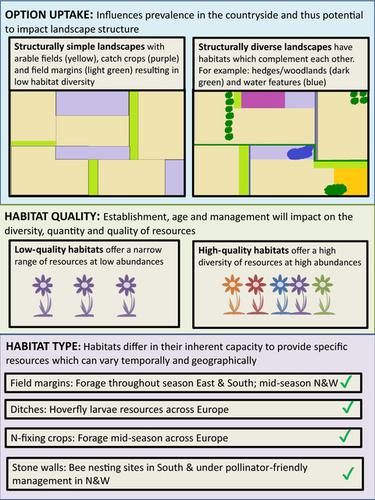当前位置:
X-MOL 学术
›
J. Appl. Ecol.
›
论文详情
Our official English website, www.x-mol.net, welcomes your feedback! (Note: you will need to create a separate account there.)
A critical analysis of the potential for EU Common Agricultural Policy measures to support wild pollinators on farmland
Journal of Applied Ecology ( IF 5.7 ) Pub Date : 2020-04-01 , DOI: 10.1111/1365-2664.13572 Lorna J Cole 1 , David Kleijn 2 , Lynn V Dicks 3, 4 , Jane C Stout 5 , Simon G Potts 6 , Matthias Albrecht 7 , Mario V Balzan 8 , Ignasi Bartomeus 9 , Penelope J Bebeli 10 , Danilo Bevk 11 , Jacobus C Biesmeijer 12, 13 , Róbert Chlebo 14 , Anželika Dautartė 15 , Nikolaos Emmanouil 16 , Chris Hartfield 17 , John M Holland 18 , Andrea Holzschuh 19 , Nieke T J Knoben 12 , Anikó Kovács-Hostyánszki 20 , Yael Mandelik 21 , Heleni Panou 16 , Robert J Paxton 22, 23 , Theodora Petanidou 24 , Miguel A A Pinheiro de Carvalho 25 , Maj Rundlöf 26 , Jean-Pierre Sarthou 27 , Menelaos C Stavrinides 28 , Maria Jose Suso 29 , Hajnalka Szentgyörgyi 30 , Bernard E Vaissière 31 , Androulla Varnava 28 , Montserrat Vilà 9 , Romualdas Zemeckis 15 , Jeroen Scheper 2, 32
Journal of Applied Ecology ( IF 5.7 ) Pub Date : 2020-04-01 , DOI: 10.1111/1365-2664.13572 Lorna J Cole 1 , David Kleijn 2 , Lynn V Dicks 3, 4 , Jane C Stout 5 , Simon G Potts 6 , Matthias Albrecht 7 , Mario V Balzan 8 , Ignasi Bartomeus 9 , Penelope J Bebeli 10 , Danilo Bevk 11 , Jacobus C Biesmeijer 12, 13 , Róbert Chlebo 14 , Anželika Dautartė 15 , Nikolaos Emmanouil 16 , Chris Hartfield 17 , John M Holland 18 , Andrea Holzschuh 19 , Nieke T J Knoben 12 , Anikó Kovács-Hostyánszki 20 , Yael Mandelik 21 , Heleni Panou 16 , Robert J Paxton 22, 23 , Theodora Petanidou 24 , Miguel A A Pinheiro de Carvalho 25 , Maj Rundlöf 26 , Jean-Pierre Sarthou 27 , Menelaos C Stavrinides 28 , Maria Jose Suso 29 , Hajnalka Szentgyörgyi 30 , Bernard E Vaissière 31 , Androulla Varnava 28 , Montserrat Vilà 9 , Romualdas Zemeckis 15 , Jeroen Scheper 2, 32
Affiliation

|
Abstract Agricultural intensification and associated loss of high‐quality habitats are key drivers of insect pollinator declines. With the aim of decreasing the environmental impact of agriculture, the 2014 EU Common Agricultural Policy (CAP) defined a set of habitat and landscape features (Ecological Focus Areas: EFAs) farmers could select from as a requirement to receive basic farm payments. To inform the post‐2020 CAP, we performed a European‐scale evaluation to determine how different EFA options vary in their potential to support insect pollinators under standard and pollinator‐friendly management, as well as the extent of farmer uptake. A structured Delphi elicitation process engaged 22 experts from 18 European countries to evaluate EFAs options. By considering life cycle requirements of key pollinating taxa (i.e. bumble bees, solitary bees and hoverflies), each option was evaluated for its potential to provide forage, bee nesting sites and hoverfly larval resources. EFA options varied substantially in the resources they were perceived to provide and their effectiveness varied geographically and temporally. For example, field margins provide relatively good forage throughout the season in Southern and Eastern Europe but lacked early‐season forage in Northern and Western Europe. Under standard management, no single EFA option achieved high scores across resource categories and a scarcity of late season forage was perceived. Experts identified substantial opportunities to improve habitat quality by adopting pollinator‐friendly management. Improving management alone was, however, unlikely to ensure that all pollinator resource requirements were met. Our analyses suggest that a combination of poor management, differences in the inherent pollinator habitat quality and uptake bias towards catch crops and nitrogen‐fixing crops severely limit the potential of EFAs to support pollinators in European agricultural landscapes. Policy Implications. To conserve pollinators and help protect pollination services, our expert elicitation highlights the need to create a variety of interconnected, well‐managed habitats that complement each other in the resources they offer. To achieve this the Common Agricultural Policy post‐2020 should take a holistic view to implementation that integrates the different delivery vehicles aimed at protecting biodiversity (e.g. enhanced conditionality, eco‐schemes and agri‐environment and climate measures). To improve habitat quality we recommend an effective monitoring framework with target‐orientated indicators and to facilitate the spatial targeting of options collaboration between land managers should be incentivised.
中文翻译:

对欧盟共同农业政策措施支持农田野生传粉媒介的潜力的批判性分析
摘要 农业集约化和相关的优质栖息地丧失是昆虫传粉媒介减少的关键驱动因素。为了减少农业对环境的影响,2014 年欧盟共同农业政策 (CAP) 定义了一套栖息地和景观特征(生态重点领域:EFA),农民可以从中选择作为获得基本农场付款的要求。为了为 2020 年后的 CAP 提供信息,我们进行了一项欧洲规模的评估,以确定不同的 EFA 选项在标准和授粉媒介友好管理下支持昆虫授粉媒介的潜力以及农民吸收的程度方面有何不同。一个结构化的 Delphi 启发式流程邀请了来自 18 个欧洲国家的 22 位专家来评估 EFA 选项。通过考虑关键授粉类群(即大黄蜂、单独的蜜蜂和食蚜蝇),每个选项都被评估为提供饲料、蜜蜂筑巢地点和食蚜蝇幼虫资源的潜力。全民教育选项在被认为提供的资源方面差异很大,而且其有效性在地域和时间上也各不相同。例如,在南欧和东欧,田间边际提供了整个季节相对较好的草料,但在北欧和西欧缺乏早季草料。在标准管理下,没有单一的全民教育选项在资源类别中获得高分,并且人们认为晚季草料稀缺。专家们确定了通过采用有利于授粉媒介的管理来改善栖息地质量的大量机会。然而,仅靠改善管理不太可能确保满足所有传粉媒介资源需求。我们的分析表明,管理不善、固有传粉媒介栖息地质量的差异以及对捕捞作物和固氮作物的吸收偏向的组合严重限制了全民教育在欧洲农业景观中支持传粉媒介的潜力。政策影响。为了保护授粉媒介并帮助保护授粉服务,我们的专家引出强调需要创建各种相互关联、管理良好的栖息地,在它们提供的资源上相互补充。为实现这一目标,2020 年后共同农业政策应以整体观点来实施,整合旨在保护生物多样性的不同交付工具(例如加强条件、生态计划以及农业环境和气候措施)。
更新日期:2020-04-01
中文翻译:

对欧盟共同农业政策措施支持农田野生传粉媒介的潜力的批判性分析
摘要 农业集约化和相关的优质栖息地丧失是昆虫传粉媒介减少的关键驱动因素。为了减少农业对环境的影响,2014 年欧盟共同农业政策 (CAP) 定义了一套栖息地和景观特征(生态重点领域:EFA),农民可以从中选择作为获得基本农场付款的要求。为了为 2020 年后的 CAP 提供信息,我们进行了一项欧洲规模的评估,以确定不同的 EFA 选项在标准和授粉媒介友好管理下支持昆虫授粉媒介的潜力以及农民吸收的程度方面有何不同。一个结构化的 Delphi 启发式流程邀请了来自 18 个欧洲国家的 22 位专家来评估 EFA 选项。通过考虑关键授粉类群(即大黄蜂、单独的蜜蜂和食蚜蝇),每个选项都被评估为提供饲料、蜜蜂筑巢地点和食蚜蝇幼虫资源的潜力。全民教育选项在被认为提供的资源方面差异很大,而且其有效性在地域和时间上也各不相同。例如,在南欧和东欧,田间边际提供了整个季节相对较好的草料,但在北欧和西欧缺乏早季草料。在标准管理下,没有单一的全民教育选项在资源类别中获得高分,并且人们认为晚季草料稀缺。专家们确定了通过采用有利于授粉媒介的管理来改善栖息地质量的大量机会。然而,仅靠改善管理不太可能确保满足所有传粉媒介资源需求。我们的分析表明,管理不善、固有传粉媒介栖息地质量的差异以及对捕捞作物和固氮作物的吸收偏向的组合严重限制了全民教育在欧洲农业景观中支持传粉媒介的潜力。政策影响。为了保护授粉媒介并帮助保护授粉服务,我们的专家引出强调需要创建各种相互关联、管理良好的栖息地,在它们提供的资源上相互补充。为实现这一目标,2020 年后共同农业政策应以整体观点来实施,整合旨在保护生物多样性的不同交付工具(例如加强条件、生态计划以及农业环境和气候措施)。



























 京公网安备 11010802027423号
京公网安备 11010802027423号